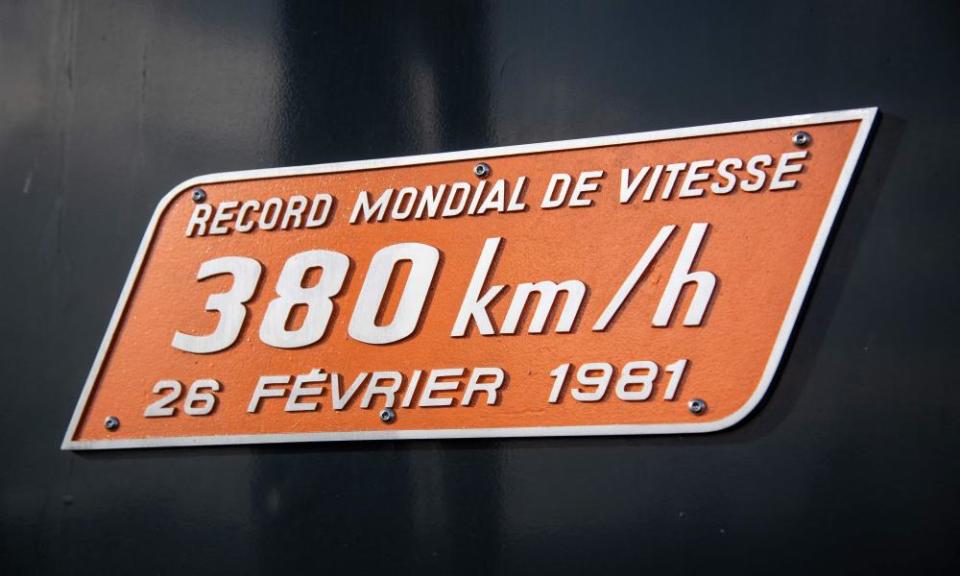France’s high-speed TGV train enters service – archive, 1981
France’s high-speed rail revolution
From our correspondent in Paris
22 September 1981
Seven months after setting the world’s rail speed record at 265 mph, France’s new superspeed train enters service today on what amounts to a Paris-Lyon Metro link.
President Mitterand will inaugurate the first important new mainline in western Europe since the turn of the century, taking a seat in the Concorde-style TGV that will link the two cities in two hours and 40 minutes.
Within two years, when trains will leave city centre stations every half hour, the 250-mile Paris-Lyon journey will take two hours, less than half the present time. By then, it is expected that the air link between the cities will be obsolete.
Related: Leader: In praise of... the TGV
Compared to its world speed record, the TGV – Train à Grande Vitesse – will doddle along at a peak speed of 180 mph at first, still 30 mph faster than its Japanese rival, the Hokaido, which inspired the French service.
But after being run-in the £850m investment – a quarter of the Concorde’s cost – will be opening a new age of travel that could eventually link London to Paris and beyond, through the Channel tunnel.
Already 87 of the trains have been built or are in service ready to link Paris to Marseille in four hours 50 minutes, only one of dozens of journeys that will be halved by the sleek orange and white locomotives.
Not only will it be faster to travel TGV than by any other means, it will also be cheaper. The price of a ticket will be the same as the present service, but it will be cheaper than any other means. Paris-Lyon will cost roughly £16, compared to nearly £40 by air. After 1985, a series of new lines will be built to the west and south-west.
Steady and silent to Lyon at 162 mph
From Walter Schwarz in Lyon
23 September 1981
The inaugural Beaujolais stayed wonderfully steady in the glass, and you could hear the rain on the roof – so quietly did the 162 mph train glide from Paris to Lyon and back yesterday, taking only two hours 40 minutes each way.
It looked and felt like an aeroplane as it pulled away from the Gare de Lyon yesterday on its first run, with President Mitterand and four ministers on board, and plenty of wine.

But a union delegation from the socialist railwaymen’s union on the platform gave the occasion an old-fashioned air. The men bellowed through loudspeakers at the VIPs as they got on the train that the new line was “undemocratic” and unfair to both railwaymen and passengers.
“What is coloured orange and goes faster that the 36-hour week?” asked their banner – a reminder that prestige technology still left people working harder than socialist promises had led them to expect. They complained that spending £850m on fast trains meant shutting down obsolete lines.
The demonstration only added to the excitement, without spoiling the feeling that a new age had dawned in which trains go nearly as fast as aeroplanes at less than half the price.
“A silly demo,” said Mr Georges Marchais, the Communist leader, as he stepped aboard, beaming – the only non-ministerial political leader on the train. “We Communists have always been for progress; this train, nuclear energy, fast breeders, reprocessing, the Concorde – we are for them all – and the Channel tunnel as well.”
He had come as guest of his friend Mr Fiterman, Communist minister of transport. Both men could ignore the socialist demonstration, in the happy knowledge that most railwaymen belong to the communist CGT.
In fact the TGV is tolerably democratic – with fares the same as old-fashioned trains, except at peak hours. There is a first-class, but second-class is more comfortable than a jet liner, with the same hostesses wheeling food and drink on trolleys. Yesterday, Chopin’s revolutionary etude sounded discreetly on the intercom to accompany the refreshments.
The aeronautic effect pervaded the driver’s cab, too. The electronic information fed to his computer practically drive the train without his help.
Related: The Guardian view on Europe by train: virtue signalling | Editorial
There is no speedometer in the compartment to keep passengers informed, as there is in the slower, less comfortable “bullet train.” The French train feels faster because it is narrower and lower, but it shakes less. The driver told us when we had crossed the 162 mph speed barrier: it was exhilarating because it really felt fast.
All the speeches yesterday were in honour of France, where the train speed record was broken in 1955 with 205 mph, and again last year with 236 mph – which remains the top speed of the new train, although it will cruise at 162 mph for the moment.

 Yahoo News
Yahoo News 
